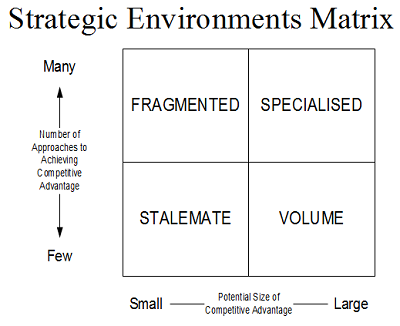The Competitive Advantage Matrix (also known as the Advantage Matrix or even the Strategic Environments Matrix) is one of the more interesting generic strategy models and was created by the famous strategy consulting firm, the Boston Consulting Group (BCG).
The Two Dimensions Of the Competitive Advantage Matrix
This is a two-by-two matrix which looks at two factors:
- The number of different approaches to competitive advantage available
- The potential size of the competitive advantage
The Four Categories In The Competitive Advantage Matrix
The competitive advantage matrix therefore has four boxes
- Few advantages – and those that exist are small – Stalemate.
.
- Few advantages – but those that exist are large – Volume.
.
- Many advantages – but those that exist are small – Fragmented.
.
- Many advantages – and they can be large – Specialised.

Since most of the possible advantages will refer to differentiation, the Competitive Advantage Matrix can also be thought of as a Differentiation Advantage Matrix.
The Origins Of The Competitive Advantage Matrix
The Boston Consulting Group had developed and popularised the ideas of managing to achieve scale economies and learning curve economies and developed the famous Growth Share matrix (this split businesses into stars, cash cows, question marks and dogs based on the growth of the industry and the relative market share of the business.)
The Competitive Advantage Matrix helped to bring out the key assumptions which made the ideas behind scale, learning and the Growth Share Matrix and explains why they worked well in some strategic environments (volume) and didn’t work so well in others.
A More Detailed Look At the Competitive Advantage Matrix Categories
Volume businesses benefit from large scale which helps them to lower production and service costs by spreading out a cost over a larger number of units. A great example is software – initial costs are enormous to develop a software program but incremental costs for the next copy are tiny. In this environment average unit costs fall quickly as volume increases.
Volume businesses also benefit from being able to spread their marketing and brand building costs over numerous sales. This is the advantage that Coca-Cola has over Pepsi. It costs each the same to create advertisements and to buy the time on TV but because Coke has approximately twice the market share, its unit costs are about half – giving Coca-Cola the choice of taking the cost advantage or spending twice as much on promotion.
Volume businesses thrive where customer needs are very similar and get into trouble as customer needs disperse across many customer value attributes.
Stalemate businesses – where there are few competitive advantages and those that could exist are small – are often trapped into thinking determined by standard industry recipes – “That’s the way this industry works, it always has done and always will do.”
As technology changes, these industries can be shaken up and the old approach made to look foolish. Think of Amazon versus music CD stores.
The Fragmented and Specialised sections are where most small businesses should be positioned, and they deserve their own special posts focusing on the opportunities. If you think that you’re trapped in a stalemate industry, you need to listen to my mp3s on the 7 big questions of business success.
Why I Like The Competitive Advantage Matrix
I like the Competitive Advantage Matrix for several reasons:
- First it shakes up the idea that big is better. It works in volume businesses but in other businesses, getting too big and expanding outside the niche damages the differentiation that creates success.
. - Second, it’s not that well known. I’ve seen it mentioned in a few books on strategy but they rarely go into much detail and instead prefer to trot out the traditional thinking from the Growth Share Matrix.
What Do You Think About The Competitive Advantage Matrix?
Do you find the insights from the Competitive Advantage Matrix useful?
Is it a self-fulfilling prophecy where businesses who think they are in a stalemate will act as if they are in a stalemate and businesses who think they can specialise will develop significant competitive advantages?
The Competitive Advantage Matrix As A Strategic Planning Model
The Advantage Matrix is one of many strategic planning models which helps you to think through a particular situation, understand the implications and possibly identify the way to improve the position of the business.
One of my favourites which isn’t as well known as it should be is SPACE Analysis which puts the level of competitive advantage into perspective with three other critical dimensions of strategy.





